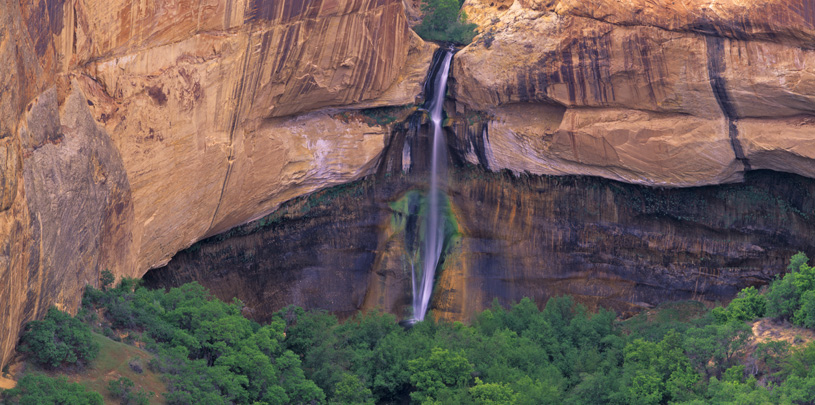
Lower Calf Creek Falls, Tom Till
 by Mike Popejoy, Research Associate
by Mike Popejoy, Research Associate
Late in 2017, President Trump unlawfully shrank the iconic Grand Staircase-Escalante National Monument by 47 percent, chopping it into three smaller units. While our lawsuit challenging that action is pending in court, last week the Bureau of Land Management (BLM), the federal agency in charge of stewarding the monument, released it proposed management plan for the three new monument units — Escalante Canyons, Grand Staircase, and Kaiparowits — and for the lands excised from the original monument. The BLM has spent over $2.3 million in taxpayer dollars in preparing this plan, which would likely be scrapped and thrown out if Trump’s action is found to be illegal.
Adding insult to injury, after considering several alternatives for managing these lands, the BLM chose the one that, by the agency's own admission, is least protective of the natural and cultural resources that make this place so special. Below is a quick rundown of what the plan would mean on the ground, if implemented. This plan is bad news both for the lands cut out of the original monument and for the shrunken monument itself, and we’ll look at each in turn.

What does the plan mean for lands excised from the original monument?
Over half a million acres open to mining and drilling
- Over 75 percent (650,000 acres) of the lands removed from the monument would be open to mineral leasing, including an area the size of Rhode Island that would be open to coal mining. Coal mining is incredibly destructive and should not be allowed on these sensitive landscapes, especially when we’re seeing coal outfits shutting down across the country due to market forces.
- Almost 600,000 acres would be opened to the sale or free use of mineral materials like sand, stone, gravel, pumice, cinders, and clay.
More cattle grazing
- Nearly all of the land removed from the monument — 98.4 percent — would now be open to livestock grazing, up from 96 percent before.
Fossils up for grabs
- Casual collection of fossils would be allowed on nearly all land removed from the monument. The original monument is one of the most paleontologically rich areas in the country. Allowing fossil collection could mean that critical information about our planet’s history will disappear from this landscape.
More off-road vehicles
- The acreage closed to off-road vehicles would go from over 444,000 acres to zero.
Logging and herbicide spraying
- Seeding non-native species and a full range of vegetation “treatments” (including chaining, which entails dragging a large chain between heavy machinery and toppling trees in its path), commercial timber harvest, and aerial spraying of herbicides would also be permitted on lands excised from the monument.
The BLM claims that since its plan allows for increased surface-disturbing activities, it will potentially increase identification of new cultural resource sites. Talk about really looking for the silver lining!
What does the plan mean for the shrunken monument?
More cattle grazing
- Nearly all of the land in the shrunken monument — 98.8 percent — would be open to livestock grazing.
- An additional 49,011 acres would be made available for livestock grazing in the Escalante Canyons unit of the monument alone. Imagine going on a remote backpacking trip along the Escalante River, the last river to be mapped in the contiguous 48 states, and having to camp amidst a minefield of cow pies, and filter water now laden with bovine excrement. Plus, this would spell the ecological decimation of an area that has been recovering for the past two decades due to the efforts of a broad array of stakeholders, including the Grand Canyon Trust.
Logging and herbicide spraying
- Chaining of pinyon and juniper trees has been prohibited since the monument was established. This is, in BLM’s own words, “due to the potential for irreversible impacts on resources, such as archaeological sites and artifacts and paleontological resources.” Under the new plan, a full range of vegetation “treatment” options would be permitted, including chaining and other mechanical, chemical, and biological methods of killing trees.
- Non-native species may be seeded to improve forage for livestock. This would essentially allow your public lands to be farmed for the benefit of private livestock operators.
- Commercial timber harvest would now be permitted on the entirety of the monument.
- Aerial spraying of herbicides would be permitted.
More roads and off-road vehicles
- Off-road vehicles would be allowed on designated routes through all wilderness study areas. This could prevent such areas from receiving wilderness designation in the future.
- Off-highway vehicles would be allowed on designated routes through river corridors that are suitable for wild and scenic river consideration.
- Two new roads are proposed — the Inchworm Arch Road in the Grand Staircase unit and the V-Road in the Escalante Canyons unit.
When it comes to Grand Staircase-Escalante National Monument, the current administration has made a habit of stifling the democratic process by disregarding the vast majority of public comments submitted. This was first demonstrated when the monument boundaries were shrunk despite overwhelming public support for keeping the monument intact. It has been shown again in this planning process, for instance, by opening the Escalante River corridor to cattle grazing despite public opposition. The administration is not only jeopardizing the integrity of some of the most spectacular and fragile public lands in our country, but also undermining the public engagement that is a pillar of our democracy.
We’re going to keep working to reverse this attack on our public lands, and we hope you’ll join us. Sign up for our action alert network ›

 by Mike Popejoy, Research Associate
by Mike Popejoy, Research Associate